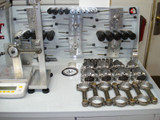What to know about camshaft selection
A camshaft upgrade is an outstanding way to add some horsepower numbers to your dyno sheet and shave some numbers off of your ET, but going bigger isn't always better in regards to camshafts. understanding how lift and duration change flow and horsepower numbers will help you make an informed selection. the easiest way to explain camshaft lift is to think of how far the valve opens to its furthest point off the valve seat, camshaft duration can be simply explained as how long the valve stays open off of the valve seat, these two very simple movements are ultimately what establish how much horsepower can be made with a camshaft, and making adjustments to these two items will change a lot within the engine. We will explain how the camshaft plays into the concept with this simple analogy. Camshafts are similar to your cell phone, they're constantly updating the software to make them better, and a camshaft is just the same thing, a consistent cycle of improvement, the bottom end of the engine is just a big air pump, so all it does is just move air around. The camshaft is the software controlling your valve movements, so if the valve timing and the amount the valves are open don't match what the heads, valtrain, or induction systems like, the engine won't make as much power as it should. Camshafts get updated like cell phone so they are smarter and make more power. If the camshaft is the brains of the operation how do you make it wiser to your combination through Lift and duration? When you look at how lift versus duration works, it becomes clear that there is needs to be proper balance between the two for the engine to function at its full potential. With today's modern engine building technology you don't need to guess on numbers or just select a camshaft based on how well it works for somebody else. Knowing your flow numbers is important to getting the right camshaft lift, if you make any changes to the cylinder such as porting, that needs to be considered when selecting a camshaft. whether or not you have enough lift or too much lift depends on air flow of your cylinder heads. It doesn't do you any good to put a .700 lift camshaft in something that has a head that quits flowing air at .500 lift. The opposite applies if you only put a .500 lift cam in an engine that is still flowing more air at .700 lift. At that point you are leaving a lot on the table because you're not getting the full potential of the engine. Getting the right duration needs to be approached slightly different. Duration is more relevant to RPM range. The less duration the camshaft has the more torque an engine will make, the higher the duration the engine will make more top end horsepower, but not as much torque. One of the reasons they don't make as much torque is because when you are increasing duration timing, it increases overlap, and that basically decreases low RPM cylinder pressure. The only way to get that cylinder pressure back in the engine is to spin it to a higher RPM level. With higher durations, the valve stay open longer, therefore they can pull more air in and out and make more power. Getting the lift and duration right on a camshaft is what will take it from just sounding good to making solid horsepower, and taking the time to speak to a camshaft Pro will make that process much easier to assist you in building a powerful engine for your application.
Recent Posts
-
Valve Spring Tech 101
The valve springs on a modified engine are subjected to extreme stress from high RPM operation, high …28th Feb 2020 -
Machined Kits
The days of having 6 to 10 machine shops in one city is no longer an option. Welcome to the new age …21st Nov 2019 -
What to know about camshaft selection
A camshaft upgrade is an outstanding way to add some horsepower numbers to your dyno sheet and shave …14th Nov 2019

